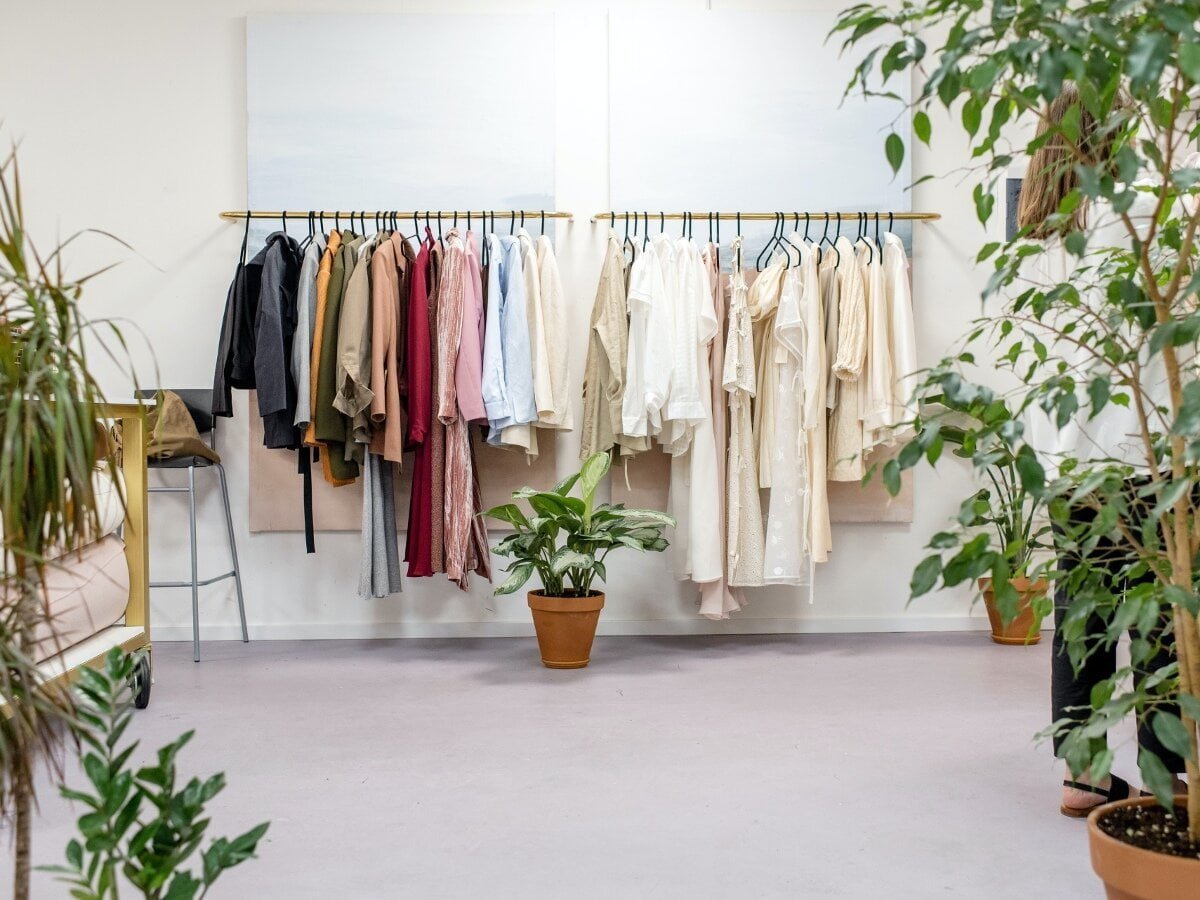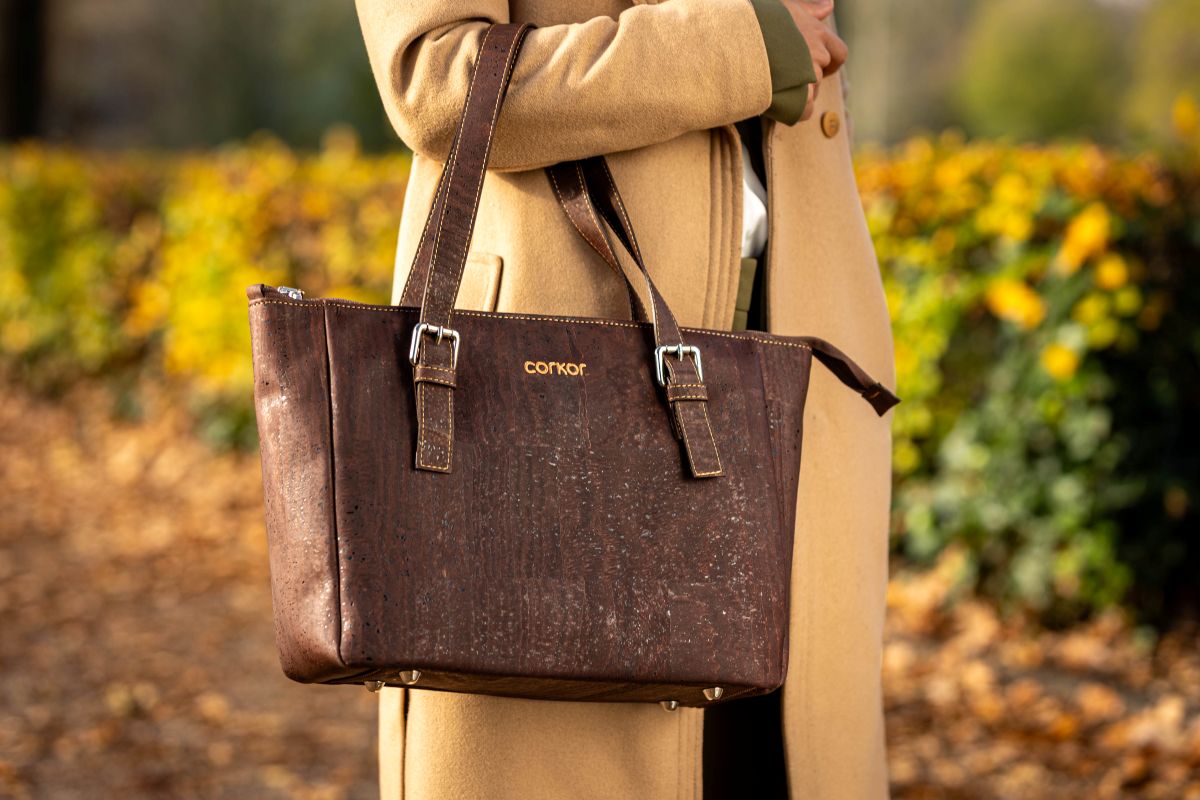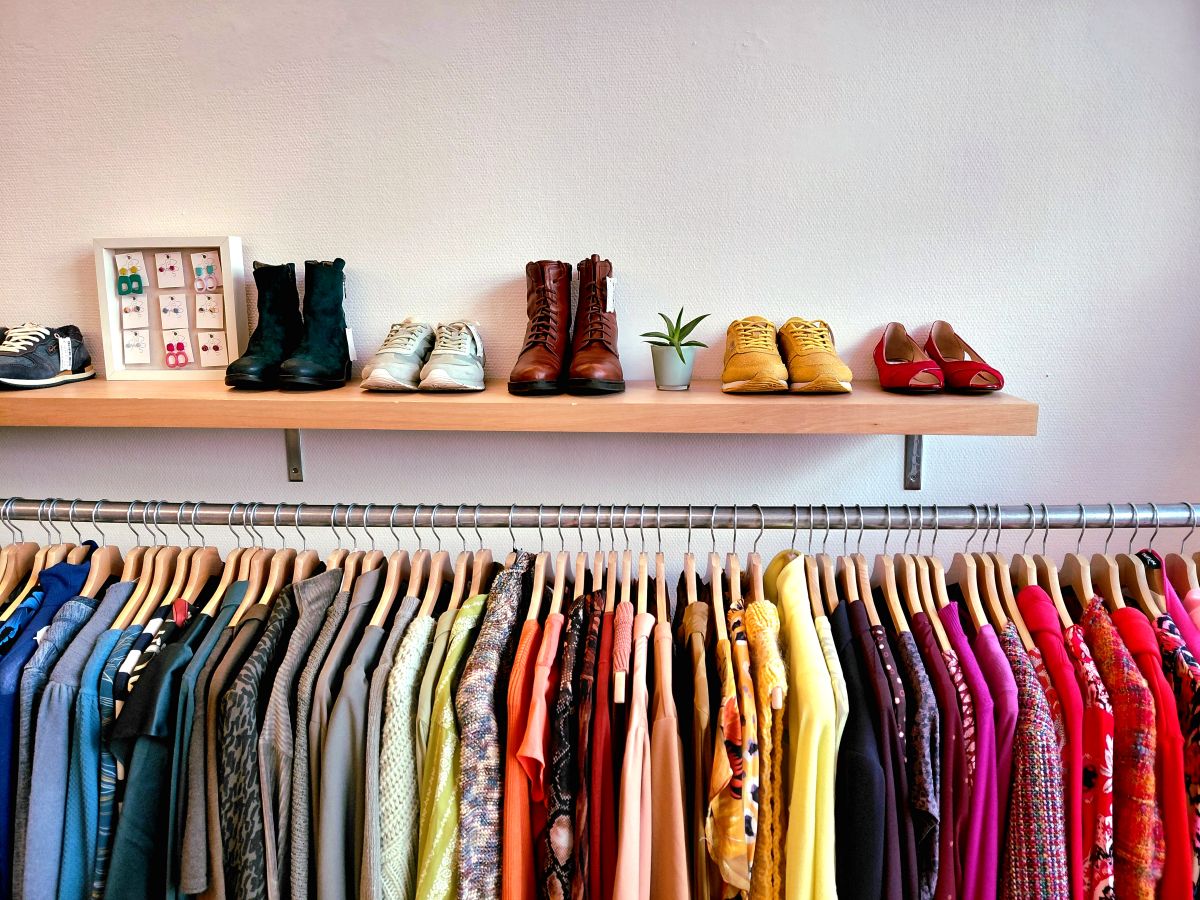You would like to buy sustainable clothing, but are not sure what to look for? A first step is to check what material your clothes are made of. If you choose natural fabrics that are made in a sustainable way, you put less pressure on our beautiful planet. At least... if you then use this beautiful garment for a long time and don't buy too many of them. But which clothing materials are really environmentally friendly? We list them for you.
Reduce the environmental impact of your clothes
The clothes we wear put a strain on the environment. Before you can hang that beautiful new blouse or cool jeans in your closet, an entire production process takes place. It requires land, water and usually pesticides and chemicals, among other things. Buying less clothes and buying clothes second-hand are two sustainable choices that will make a big difference (because clothing production is incredibly polluting and we buy too much on a massive scale). But there is more you can pay attention to if you want to reduce your footprint: namely, the material your clothes are made of.
What clothing materials are there?
If you start studying the labels of your garments, you are likely to come across many different terms. Besides cotton, for example, polyester, acrylic, nylon, elastane and viscose are fabrics you often come across. Which clothing materials are sustainable and which would you rather avoid?
Why you want to avoid plastic clothing materials
Fabrics such as polyester, acrylic, polyamide, lycra, spandex and elastane are all made of petroleum. So it is basically plastic what you wear. Besides polluting the environment during production, these synthetic fabrics also release microplastics during washing and wearing. These microplastics then end up in nature, in our food and also in our bodies. Microplastics are everywhere on earth (even at the North Pole!) and recent studies have shown that they are already everywhere in our human bodies too. Microplastics have been found in our lungs, in our blood and even in the placenta of unborn babies. Did you know that 35% of microplastics pollution in the oceans comes from the textile industry! So a good reason to choose fabrics of natural origin if at all possible. You can read more about synthetic clothing and microplastics in this article.
Side note: sometimes synthetic materials do come in handy, think of a mackintosh or swimming costume. Then recycled PET, for example, is a good option. Moreover, with these garments you do not have to worry as much about spreading microplastics, because it is a smooth fabric. More information can be found in this article on sustainable swimwear.


Second-hand shopping is a sustainable choice, even then you can pay attention to clothing materials.
Sustainable clothing materials
Just because a fabric is made of natural material does not mean it is a sustainable fabric. Natural materials need land and sometimes pesticides to grow. Moreover, natural materials often require chemicals during processing and treatment. Therefore, it remains wise to buy as few new clothes as possible. But do you really need something new? Then you can make sure you buy a garment made of an eco-friendly fabric. The following fabrics are at least a lot more sustainable than the material most fast fashion is made of.
Tencel
If you look for a sustainable fabric, you are bound to come across Tencel. Tencel is the brand name for Lyocell produced by Austrian firm Lenzing. Lyocell is considered a ‘natural synthetic fibre’ because it has wood pulp as its natural base, but is converted into usable fibre using chemicals. Tencel is made from sustainably grown eucalyptus trees, which require less water and pesticides than cotton. The chemicals used to soften the wood pulp are filtered out of the water and reused. Tencel is a soft, supple and temperature-regulating material that is nice to wear. It looks a bit like silk.
Ecovero
Like Tencel, Ecovero is also a Lyocell fabric made by the company Lenzing. Ecovero is made from sustainable wood sourced from controlled forests in Europe that are FSC and PEFC certified. Like Tencel, the fabric is certified with the EU Ecolabel and is said to be even slightly more sustainable than Tencel. Ecovero, like Tencel, is a dashing and airy fabric.
Are viscose, rayon and modal sustainable clothing materials?
Like Tencel and Ecovero, viscose, rayon and modal are also semi-artificial fabrics made from natural materials (plants and trees) that are then treated with chemicals. With these clothing materials, it is just not clear under what conditions they were made. Do the raw materials come from sustainable forests? What were the conditions of the workers in the factories? Are the chemicals required during the production process collected in a closed system or dumped in nature? Because viscose, rayon and modal are often produced under poor conditions for people and nature, it is better to leave these fabrics hanging in the shop. Rather choose Tencel or Ecovero.





Left: At sustainable fashion retailers like Sophie Stone, they pay attention to materials when sourcing their clothes. You can also read more about recycled materials here. Below: jeans made of recycled and organic cotton, a Skirt made of the sustainable material Ecovero and on the right, a vintage wool coat together with an alpaca wool scarf. Find out how sustainable alpaca wool is in this article.
Bamboo
Bamboo fabric is a type of viscose. Viscose is made from wood pulp, which is then processed using a chemical process. The wood pulp can come from different types of wood, including bamboo. Bamboo is often touted as a sustainable material. Unfortunately, bamboo's green image does not quite prove to be true. Bamboo is a fast-growing plant that requires very little care and water. So in that respect it is very sustainable. But how do you turn those hard bamboo stalks into soft fabric? Most bamboo fabric is made by a chemical process. The chemicals used are not only harmful to workers, but often end up in nature. Want to make sure you buy sustainable bamboo? Then choose tanboocel bamboo viscose, as it is made with a closed-loop process.
Closed-loop means that the chemicals used are filtered back out of the water and reused.
Bamboo is a fine soft fabric that is cooling in summer and warming in winter. Want to know more about the production process of bamboo? We have written about this at length before.
Organic cotton
Cotton is a natural material. Because of this, many people think it is a beautiful and sustainable alternative. But unfortunately, this is usually not the case. A lot of chemicals, fertilisers and pesticides are used to grow cotton. These are not only harmful to the environment, but also to the people working in the cotton industry. That is why it makes sense to go for organic cotton with a label, such as the GOTS label, to choose. Although organic cotton does have the disadvantage that it requires more agricultural land. We also examined cotton in detail earlier. Recycled cotton (which is usually combined with organic cotton) is even a bit more sustainable, but unfortunately not yet widely available in shops. Want to know more about this? In this article, we list all recycled clothing materials for you.
Linen
Linen is a natural material obtained from the flax plant. The load on water and land is much smaller than for cotton. Few chemicals are needed to grow the flax plant. Still, it is wise to choose organic linen to ensure that no artificial fertilisers, pesticides and genetically modified seeds have been used. Because it takes a lot of work to turn flax into a textile fibre, linen does come at a price. Linen is a fine airy fabric, but does crease quickly.
Hemp
Hemp is a natural material that can grow almost anywhere in the world without the use of pesticides or chemicals. It grows quickly and producing hemp dust also requires few chemicals, which can then be easily filtered out of the water. Hemp is a durable material as it is strong and long-lasting. Processing hemp fibre into fabric is a bit trickier than for many other natural fibres, though. Because hemp is a hard fabric, the fibres have to be processed or mixed with another fabric, such as cotton. The disadvantage of blended fabrics is that they are more difficult to recycle. You can read more about hemp as a raw material in this article.
Recycling of clothing materials
Recycling textiles would be a great step towards a circular economy. Unfortunately, recycling clothes is a lot less easy than the fast fashion advertisements would have us believe. Currently, only 1% of all discarded textiles are recycled into new clothes. Of all textile waste, 12% is downcycled into a lower-value product, while 87% simply goes to waste.
There are two ways in which clothes can be recycled: mechanical recycling and chemical recycling. The process of mechanical recycling involves cutting and fibreising textiles, after which they are spun into new yarn. This type of recycling is suitable for cotton and wool. How strong the recycled fibres end up being depends on the quality of the original textile. Often, another new fibre is added to the recycled material to ensure that the new yarn is strong enough. Fabrics consisting of a mix of natural and synthetic material are more difficult to recycle. This is because this requires a chemical process to remove one of the two materials.
Source: Cosh!
Organic wool
Wool is a natural material that lasts a long time. The special thing about wool: it is temperature-regulating and dirt-resistant. As a result, it has the advantage that you don't have to wash it as often as clothes made of other materials. Choose organic wool to make sure it has not been treated with chemicals. Unfortunately, wool can hide animal suffering. Sometimes the tails and parts of the backs of sheep are removed to prevent parasites from getting into them. Therefore, always choose wool that muesling free is. Unfortunately, wool also has drawbacks: the methane released by sheep's farts causes CO2 emissions. Moreover, sheep need a lot of land and a lot of water (and often pesticides) are used during production. If you have the option, opt for recycled wool. You can read more about sustainable wool in this article.
Wild/ Áhimsa silk
Silk is a natural fibre made from the cocoon of the silkworm. To prevent the silk thread from breaking when the butterfly hatches, the caterpillars are killed by hot vapour or boiling water. So now you know where that shiny silk comes from. Organic silk is not much better, as the caterpillars will be fed organic leaves, but will still be killed. What is an animal-friendly option though: wild/ Áhimsa silk. Here, cocoons are collected after the butterfly has fledged. Because the threads are broken, there are tiny knots in them, making it harder to make a smooth fabric. You can read more about silk in this article.
How do you create a wardrobe with sustainable clothing materials?
If you are just starting to create a sustainable wardrobe and start paying attention to what materials your clothes are made of, you will probably find that a lot of your clothes are made of synthetic materials. To throw away most of your clothes at once and buy everything new doesn't seem very sustainable to me either.
The first step I made when I wanted to make my wardrobe more sustainable: if I need something new, I buy it second-hand (except underwear) and from sustainable materials. The next step was, I started picking out my closet and looking at the labels the fabrics were made from. Since my wardrobe was too full anyway, I got rid of everything that was made of a synthetic material and that I didn't like to wear so much, to the textile bin. synthetic items that I think are really cool? I try to wear those only on special occasions and wash them as little as possible. Because washing releases most of the microplastics.
This way, my wardrobe is gradually becoming more durable and I also have more overview and less choice stress at the same time. Eventually, I think it would be cool to have a capsule wardrobe with only eco-friendly fabrics. But since I buy few new clothes, I think it will be some time before I reach that point.
Will you buy eco-friendly clothing materials from now on?
After reading this article, you can make an informed choice on sustainable clothing materials. Unfortunately, even sustainable fabrics have an impact on the environment. Therefore, it is wise to buy as few new clothes as possible. Then, if you do need some, see if you can find it second-hand first. With any luck, you'll find a second-hand gem made from an eco-friendly fabric.
More green fashion tips from thegreenlist.nl
- Not only can you choose the material of clothes more sustainably, but also how the clothes are dyed. Check out more sustainable alternatives to textile dyes here.
- Wondering how sustainable vegan leather is? You can read all about it in this article.
- This is how to keep a wool-silk shirt looking great: handy laundry tips
- Wondering what environmental impact is behind that nice warm fleece jumper? You can read it here.
Sources: Milieu Centraal On the environmental impact of clothing, Plastic Soup Foundation On microplastics in clothing, the Sustainable Department Store On Tencel, Ecovero, Viscose, Rayon and Modal, Growthinkers On sustainable fabrics, This is a good guide by Marieke Eyskoot and The green mum By Kari van der Heide. Photo credits: main image: Ksenia Chernaya (Pexels), clothes rack: Cottonbro Studio (Pexels), other photos: thegreenlist.nl.












